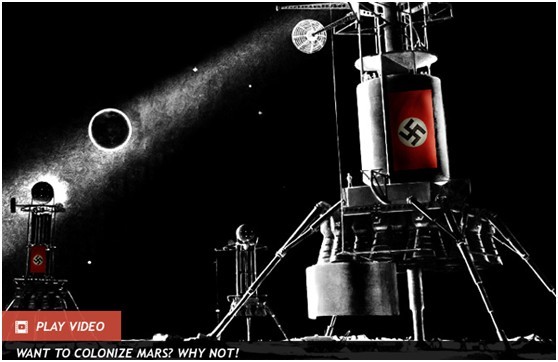

A celestial object that at first looks like a moving star enters the inky black sky above the far northern edge of the moon’s Ocean of Storms. The descending vehicle resembles an enormous flying water tower. A blinding dust storm kicks up under the spidery legs of the 160-foot tall Erector-set of girder work and fuel tanks nestled beneath a giant sphere with portholes.
Several space-suited figures climb down a long ladder. They erect a flag bearing a black swastika on a blood-red background. The German Third Reich claims ownership of the moon.
The year is 1976. The United States would have been celebrating its bicentennial except that what’s left of our nation has been reduced to those states east of the Rockies. They have united with several former Canadian provinces to form the North American Confederation. Nazi Germany and the Japanese Empire have split ownership of most of the rest of the planet. The world map looks like a tumultuous Risk board game.
This describes a “Twilight Zone”-ish parallel universe of what might have happened if the Nazis won World War II. There have been many alternative history scenarios written that explore just such a tragic ending to the deadliest war in human history. The possibility of a Nazi victory is not too farfetched.
In my time-warped universe, President Franklin Roosevelt does not run for a third term in 1940. Republican Senator Robert Taft wins the White House.
Because Taft is a staunch isolationist, the Japanese decide against doing a reckless, preemptive attack on the U.S. fleet at Pearl Harbor.
America is finally forced to enter the war following the fall of Great Britain. But it’s too late. The Nazis have had time to perfect rocket-propelled intercontinental bombers among other super-weapons.
Though the alternative future that would have followed a Nazi victory is pure conjecture, the German road to space is much clearer. In the late 1940s and early 50s the writings of German rocket pioneer Wernher von Braun (shown above), who first developed liquid fueled rockets as military weapons, spelled out the strategy he would have used to go beyond Earth.
In reality von Braun and much of his rocket team surrendered to the Allies at the end of WWII. He went on to build the Saturn V moon rocket for the Apollo missions.
If a victorious German empire instead emerged from WWII, von Braun might have been able to convince his Nazi overlords to devote exorbitant resources to fulfilling his childhood dream of space conquest. At the least he could have piggybacked on Nazi space militarization.
During WWII German engineers saw a clear advantage to putting weapons into space. They conceived of a gigantic space mirror, affixed to a space station, which could focus sunlight to incinerate targets as easily as frying an ant under a magnifying glass. No doubt Earth surveillance from the “high ground” would be developed too.
Free of the messy political seesaw that takes place in democracies, Nazi Germany may have made a long-term commitment to manned expeditions to other planets. This might have been revered as manifest destiny for the planned “1,000-year Reich.”
There would be no U.S.-Soviet style space race because Germany would have knocked out any adversarial emerging superpowers. The Germans therefore could have methodically taken their time to build up a robust and well-supported space transportation infrastructure.
The first step would have been to develop heavy lift cargo vehicles (which NASA is revisiting now, 40 years after President Richard Nixon killed the Saturn V program). Super-rockets might be a spinoff from a Nazi military goal of quickly dispatching troops anywhere on the globe via giant suborbital transports. Just several flights of the mega-boosters would have been needed to construct a huge bicycle-wheel shaped space station. The 150-foot diameter spinning torus would provide artificial gravity to a crew of 80 astronauts, as imagined by von Braun.
Von Braun saw the station as the staging area for constructing large interplanetary spacecraft that could be massive and not restricted by aerodynamic design needed to ascend from Earth. Germany would have eventually used nuclear power to achieve beefy space energy resources and propulsion systems (though not predicted by von Braun).
In his writings von Braun envisioned a major sortie to the moon that would land 50 astronauts for an initial six-week stay. They would live inside a five-floor sphere atop a cluster of fuel tanks. This was simply enormous by Apollo standards – no man in a can!
A huge remote controlled cargo vessel would accompany the manned vehicle to a landing site near the moon’s north pole. It would carry rovers with a 250-mile range capability. There would be construction supplies to build an Antarctic-style scientific outpost.
ANALYSIS: What Would a Soviet Moon Landing Have Looked Like?
Von Braun thought big. Like Heman Cortez’s fleet of 11 ships and 500 men sent to the New World in the 16th century, Von Braun envisioned a flotilla of 11 manned vessels carrying 70 astronauts to Mars. It would require the equivalent of nearly 300 Saturn V launches to carry all the parts into low Earth orbit for assembly. The fleet concept provided a lot of redundancy and carried along plenty of contingency supplies for the three-year mission. Unlike the Cortez expedition, this would not be a one-way trip.
German engineering prowess and the political stability of a dictatorship could have realized such an ambitious program. Humans might have made it to Mars before 2001, and begun interplanetary colonization before 2100.
But the thought of swastika-emblazoned spacecraft plying the solar system is downright chilling. And it leaves us with an equally chilling thought that the first interstellar species we encounter may be descended from an aggressive and warlike super-technological civilization that started out by enslaving their entire home planet.



















